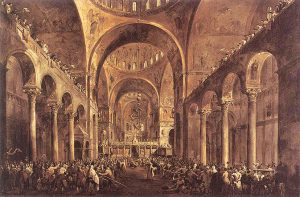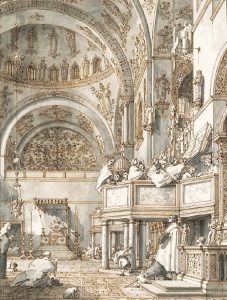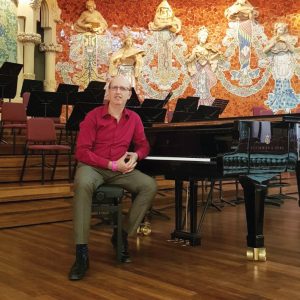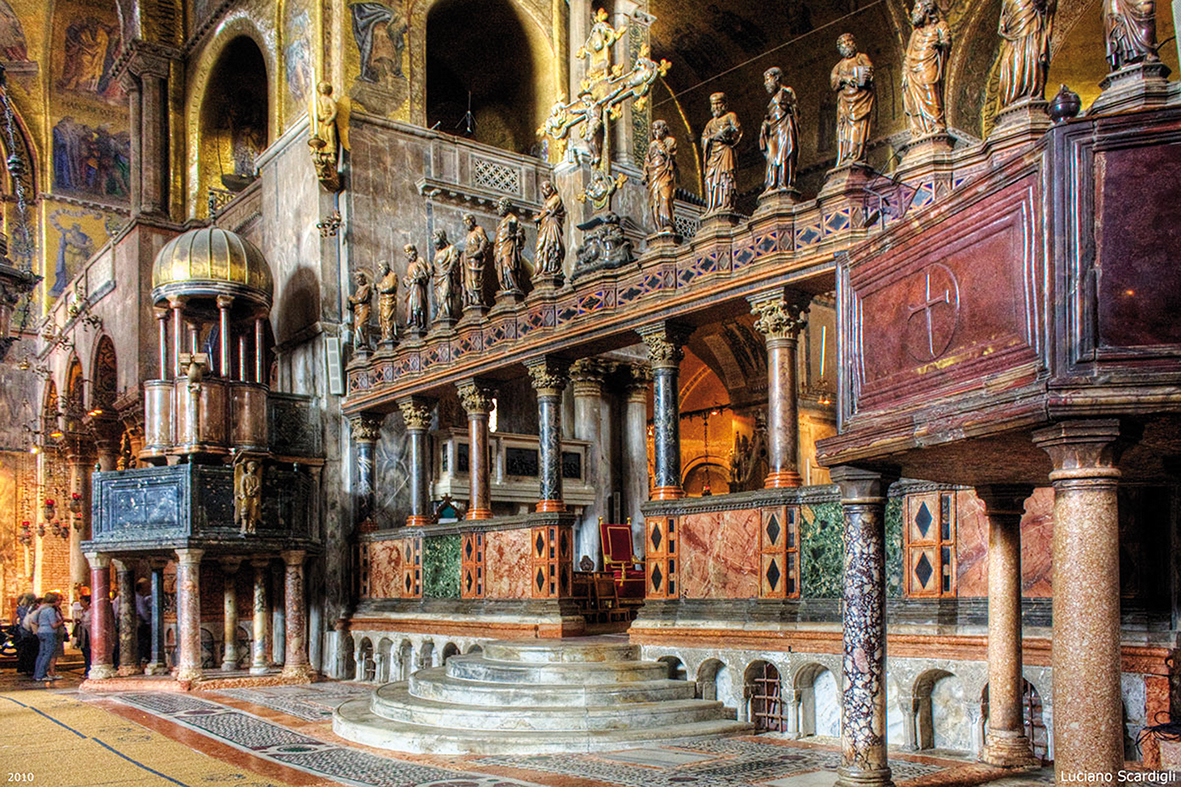Andrea Angelini, Choral Conductor, Professor and Musicologist
Thanks to the research carried out in recent years, our current understanding of the music chapel in St. Mark’s in Venice has greatly expanded. Extensive investigations have shed light on various aspects of the ducal basilica and the city of Venice as a whole. Recent studies have explored the structure of the music chapel, the biographies of its members, the patronage and financial support system, the church’s liturgy, the ducal ceremonial, and their relationship with the liturgical and figurative chant repertoires used at the basilica. In this presentation, we will outline the characteristics of the Marcian chapel during the Counter-Reformation period, along with some general observations and speculations.

During the time when St. Mark’s Basilica served as the private chapel of the doge until the Republic’s downfall, the doge held formal authority over the chapel. Doge Andrea Gritti directly intervened to secure the election of Adrian Willaert as the choir master. Some doges and their successors occasionally interfered with the church’s affairs to modify the chapel’s regulations. However, the actual governance of the church, including the hiring and firing of musicians, was mainly delegated to the three life-elected members of the Procuratia de Supra. Some of these members were renowned for their cultural commitment even in their personal lives. The recruitment of new music chapel members involved Marcian singers traveling outside Venice and, more significantly, diplomatic channels represented by mainland city authorities, ambassadors, and Venetian residents abroad. These channels played a crucial role in electing the chapel master (a decision that required careful consideration) and, in some cases, castrated sopranos.
In November 1562, the singers at St. Mark’s were divided into two groups: the large chapel and the small chapel. The large chapel, which consisted mostly of the best and most reliable singers, had 20 members (4 sopranos, 5 contraltos, 3 tenors, 3 basses, and 5 putti sopranos). They were responsible for singing “every day of the week except Thursdays and Fridays”. On the other hand, the small chapel, comprising 2 sopranos, 4 altos, 3 tenors, and 5 putti sopranos, sang specifically on feast days falling on Thursdays and Fridays. Additionally, the small chapel had to be present in the basilica and at the disposal of the maestro di cappella during the Doge’s church visits, on days and vigils of solemn feasts when the golden altarpiece was opened. However, they would only sing upon the maestro’s request.

The salaries of the singers varied significantly. In the 1560s, they ranged from a minimum of 30 ducats to a reasonably high maximum of 80. Throughout the following century, the remuneration of 100 ducats annually, granted to some singers hired towards the end of the sixteenth century, remained unsurpassed.
Regarding the polyphonic obligations of the singers during Mass and Vespers, an ordinance from 1562 emphasized the importance of singing the Sanctus, Agnus Dei, and post-Communio of the Mass, as well as the Pleni, and Osanna and during the Elevation. The singers were instructed to perform these pieces diligently with their designated voice parts, avoiding hasty renditions.

The relatively large size of the chapel and the prominent presence of polyphonic music in the liturgical ceremonies aimed to create an image befitting a grand State chapel. The concept of exclusivity also played a role in symbolically defining the institution and the State. St. Mark’s possessed a unique liturgy, liturgical chant, and ducal ceremonial, fiercely protected by the leaders of the Venetian Church and State against the centralizing efforts of the Counter-Reformation Church in Rome, which sought to standardize the rite based on the Tridentine model. Although not strictly exclusive, the practice of performing the Vesper psalms in double choir on major feasts was distinctive. Historical documents from St. Mark’s reveal that dividing the chapel into two groups for these psalms, with four singers in one choir and the remaining members in another, was rooted in an older tradition of performing the relevant liturgical chant.
A hypothesis suggests that the liturgical and paraliturgical texts set to music for large ensembles served as religious allegories representing significant events in the civil life of the Serenissima, akin to the figurative allegories depicted by artists like Veronese or Tintoretto. As St. Mark’s was the official church of the State, it provided a platform to solemnize important events for the Republic alongside regular liturgical celebrations. It is reasonable to assume that, as part of these celebrations, texts from the liturgy that allegorically expressed precise moments in Venetian history were chosen for rhetorical emphasis through grand organ compositions. Non-liturgical texts were likely written with similar intentions. The “mythical” image of Venice, conveyed through historiography, political treatises, and oratory, highlighted the harmonious relationship between temporal and spiritual governance, emphasizing themes such as the city’s divine origin and the inspiration behind its laws and constitutions.
Bibliography
- BRYANT, D (1979). Liturgia e Musica liturgica nella fenomenologia del ‘Mito di Venezia’. In G.M altri, Mitologie. Venezia: Morelli.
- BRYANT, D (1981). The Cori Spezzati of St. Mark’s: myth and reality. Early Music History (I), 165-86.
 Born in Bologna, Italy, Andrea Angelini studied piano and choral music at the Conservatoires of Rimini and Ferrara, where he got a Master. He got his Doctorate in Choral Music at the Cesena Conservatoire of Music. He studied Renaissance Choral Music in England and Rome. He is the Artistic Director and Conductor of the professional group Musica Ficta Vocal Ensemble. For many years, Andrea Angelini has conducted concerts with the choir Carla Amori, in Italy and abroad. He has also conducted, as guest conductor, many important ensembles. He has been member of the Jury at many International Choir’s Competitions in Italy, Europe and Asia. He frequently leads choral workshops in Italy and abroad. (Hungary, Malaysia, Russia, China, Moldavia, Romania, Croatia). Mr. Angelini is also the artistic director of the Rimini International Choral Competition, Claudio Monteverdi Choral Competition, Queen of the Adriatic Sea Choral Festival and Competition and Liviu Borlan Choral Festival. He has been for 11 years the Editor of the International Choral Bulletin (ICB), the membership magazine of the IFCM (International Federation for Choral Music). Actually, he is the President of AERCO, the Emilia-Romagna Regional Association of Choirs. Andrea Angelini teaches Choir Conducting at the Conservatoire of Music in Castelfranco Veneto, Livorno and Reggio Emilia. thechoralconductor@gmail.com
Born in Bologna, Italy, Andrea Angelini studied piano and choral music at the Conservatoires of Rimini and Ferrara, where he got a Master. He got his Doctorate in Choral Music at the Cesena Conservatoire of Music. He studied Renaissance Choral Music in England and Rome. He is the Artistic Director and Conductor of the professional group Musica Ficta Vocal Ensemble. For many years, Andrea Angelini has conducted concerts with the choir Carla Amori, in Italy and abroad. He has also conducted, as guest conductor, many important ensembles. He has been member of the Jury at many International Choir’s Competitions in Italy, Europe and Asia. He frequently leads choral workshops in Italy and abroad. (Hungary, Malaysia, Russia, China, Moldavia, Romania, Croatia). Mr. Angelini is also the artistic director of the Rimini International Choral Competition, Claudio Monteverdi Choral Competition, Queen of the Adriatic Sea Choral Festival and Competition and Liviu Borlan Choral Festival. He has been for 11 years the Editor of the International Choral Bulletin (ICB), the membership magazine of the IFCM (International Federation for Choral Music). Actually, he is the President of AERCO, the Emilia-Romagna Regional Association of Choirs. Andrea Angelini teaches Choir Conducting at the Conservatoire of Music in Castelfranco Veneto, Livorno and Reggio Emilia. thechoralconductor@gmail.com

